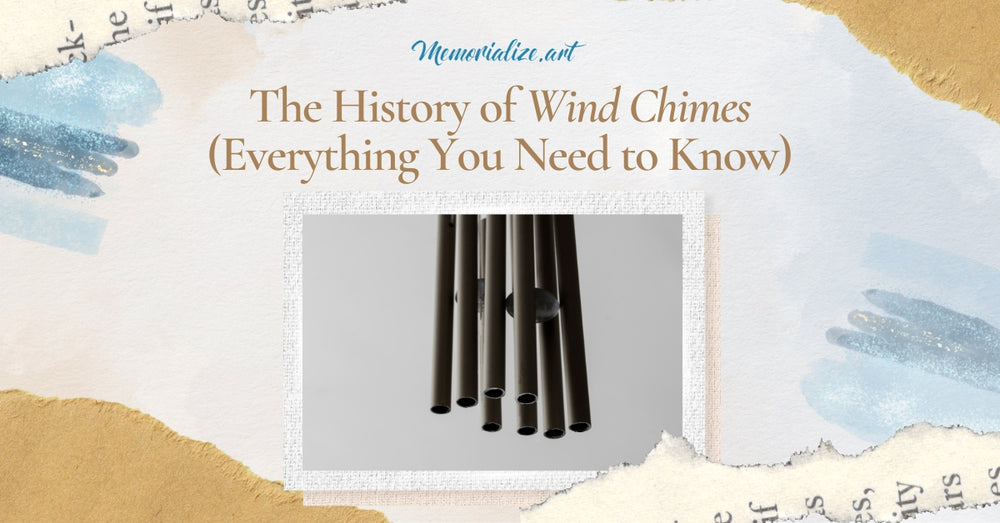The History of Wind Chimes (Everything You Need to Know)

In Asian countries and Western countries, wind chimes have been used as decorative items, spiritual symbols, or a Feng Shui tool that wards off evil spirits. Hanging from windows, porches, and gardens, these wind bells that make music have a long past connected to many different cultures worldwide.

Let's go on a fascinating trip to learn the history of wind chimes and their versions in other countries.
What Are Wind Chimes?

We often see these tubular bells as accessories for gardens or hanging from porches. These decorative items are made of tubes, rods, or bells that are hung and hit each other to make melodic sounds.
In general, all types of wind chimes are musical instruments that create a beautiful sound because of the vibrations from the tube material when winds pass across them. Each chime or rod makes various tones based on length, width, and material.
When and Where Were Wind Chimes First Invented?
Wind chimes have been around since prehistoric times. These have been around for more than 5,000 years since they were first found in archaeological sites from ancient China. From China, wind chimes gradually spread to other cultures and regions. However, there is still a varied history about the origin of wind chimes.
The advancement of wind chimes evolved in terms of various materials, designs, ornamental shapes, and purposes. Today, modern wind chimes are cherished not only for their pleasant sound but also for their aesthetic appeal and the peaceful atmosphere it brings. High-quality wind chimes are durable materials that can withstand any wind speed.
Wind Chimes in The Ancient Times

Early chimes were made from organic materials. People thought they brought positive energy and used them as a protective charm for spiritual and practical reasons. The soft tinkling sounds of wind chimes are said to have been thought to keep away evil spirits and bring good luck.
Some countries used metal tubes, aluminum tubes, and glass pieces. Metal workers carefully craft these and often feature designs used in religious ceremonies.
How Did Wind Chimes Spread to Other Parts of The World?
Over time, wind chimes slowly spread from China to other places and nations. As people moved from continent to continent, wind chimes changed, taking on new shapes and materials based on what was available and what people liked.
Wind Chimes in China
In Chinese culture, these are used in homes and Asian temples to keep negative energies away. But they are more than just ornaments. The sound of wind chimes makes play a significant role in Feng Shui. It provides a sense of balance in life and harmonizes the energies in the environment.
They hang these Chinese wind bells near entryways, windows, sacred structures, and gardens to encourage positive vibes.
Bamboo wind chimes are most commonly used in the country. Its hollow, cylindrical tubes produce gentle, resonant tones when struck by the wind. Some homes also use iron wind chimes since they have vibrant and long-lasting tones.
Wind Chimes in Japan
During the Heian period in Japan (794-1185), wind chimes, known as "Furin," gained popularity. These glass or metal wind chimes quickly became essential to the eaves of temples or Japanese houses in summer or during Furin festivals. Hanging a set of Furin wind chimes near a window or in a garden was a great way to create a relaxing ambiance.
According to Japanese superstition, wind chimes are religious objects that have the power to cleanse the environment and bestow good fortune on those who hear them. People say that soft melodies from this type of wind chime link the world of the living to the world of the dead.
The principles of Zen Buddhism, which include minimalism, awareness, and reverence for the natural world, are reflected in wind chimes. Its soothing sound can help set the mood for meditation in a Buddhist temple, allowing its listeners to relax into the present moment and discover the calm within themselves.
Wind Chimes in Europe
Despite their more common association with Asian culture, wind chimes have significantly impacted European gardens, porches, and homes by adding a sense of peace and elegance to their surroundings.
The Greeks and Romans used metal wind chimes with multiple tubes or metal bells suspended from a central piece. In Italy, Spain, and Portugal, the chimes are made of glass or ceramic and feature vibrant colors, intricate patterns, and delicate forms.
Modern European artisans have taken up the tradition of crafting wind chimes, revamping them with modern aesthetics and materials. Today, modern wind chimes serve as an outdoor display in many different styles, from traditional and rustic to sleek and simple.
Give Your Home a Peaceful Atmosphere With Wind Chimes From Memorialize Art
Wind chimes from Memorialize Art can make a place feel calm and peaceful. Each wind chime is made with care and precision using high-quality materials to ensure it sounds good and lasts a long time. These wind chimes provide a soothing ambiance wherever they are hanging, from the garden to the porch to the window sill, prompting the listener to reflect.










